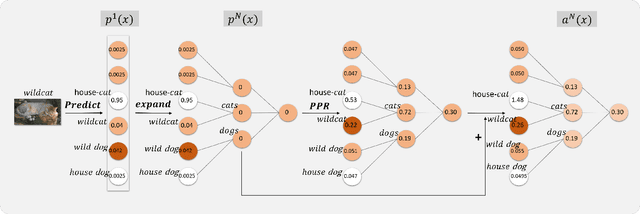Jingzhi Guo
Gradual Domain Adaptation for Graph Learning
Jan 29, 2025



Abstract:Existing literature lacks a graph domain adaptation technique for handling large distribution shifts, primarily due to the difficulty in simulating an evolving path from source to target graph. To make a breakthrough, we present a graph gradual domain adaptation (GGDA) framework with the construction of a compact domain sequence that minimizes information loss in adaptations. Our approach starts with an efficient generation of knowledge-preserving intermediate graphs over the Fused Gromov-Wasserstein (FGW) metric. With the bridging data pool, GGDA domains are then constructed via a novel vertex-based domain progression, which comprises "close" vertex selections and adaptive domain advancement to enhance inter-domain information transferability. Theoretically, our framework concretizes the intractable inter-domain distance $W_p(\mu_t,\mu_{t+1})$ via implementable upper and lower bounds, enabling flexible adjustments of this metric for optimizing domain formation. Extensive experiments under various transfer scenarios validate the superior performance of our GGDA framework.
AIDA: Legal Judgment Predictions for Non-Professional Fact Descriptions via Partial-and-Imbalanced Domain Adaptation
Feb 12, 2023Abstract:In this paper, we study the problem of legal domain adaptation problem from an imbalanced source domain to a partial target domain. The task aims to improve legal judgment predictions for non-professional fact descriptions. We formulate this task as a partial-and-imbalanced domain adaptation problem. Though deep domain adaptation has achieved cutting-edge performance in many unsupervised domain adaptation tasks. However, due to the negative transfer of samples in non-shared classes, it is hard for current domain adaptation model to solve the partial-and-imbalanced transfer problem. In this work, we explore large-scale non-shared but related classes data in the source domain with a hierarchy weighting adaptation to tackle this limitation. We propose to embed a novel pArtial Imbalanced Domain Adaptation technique (AIDA) in the deep learning model, which can jointly borrow sibling knowledge from non-shared classes to shared classes in the source domain and further transfer the shared classes knowledge from the source domain to the target domain. Experimental results show that our model outperforms the state-of-the-art algorithms.
NI-UDA: Graph Adversarial Domain Adaptation from Non-shared-and-Imbalanced Big Data to Small Imbalanced Applications
Aug 12, 2021



Abstract:We propose a new general Graph Adversarial Domain Adaptation (GADA) based on semantic knowledge reasoning of class structure for solving the problem of unsupervised domain adaptation (UDA) from the big data with non-shared and imbalanced classes to specified small and imbalanced applications (NI-UDA), where non-shared classes mean the label space out of the target domain. Our goal is to leverage priori hierarchy knowledge to enhance domain adversarial aligned feature representation with graph reasoning. In this paper, to address two challenges in NI-UDA, we equip adversarial domain adaptation with Hierarchy Graph Reasoning (HGR) layer and the Source Classifier Filter (SCF). For sparse classes transfer challenge, our HGR layer can aggregate local feature to hierarchy graph nodes by node prediction and enhance domain adversarial aligned feature with hierarchy graph reasoning for sparse classes. Our HGR contributes to learn direct semantic patterns for sparse classes by hierarchy attention in self-attention, non-linear mapping and graph normalization. our SCF is proposed for the challenge of knowledge sharing from non-shared data without negative transfer effect by filtering low-confidence non-shared data in HGR layer. Experiments on two benchmark datasets show our GADA methods consistently improve the state-of-the-art adversarial UDA algorithms, e.g. GADA(HGR) can greatly improve f1 of the MDD by \textbf{7.19\%} and GVB-GD by \textbf{7.89\%} respectively on imbalanced source task in Meal300 dataset. The code is available at https://gadatransfer.wixsite.com/gada.
 Add to Chrome
Add to Chrome Add to Firefox
Add to Firefox Add to Edge
Add to Edge